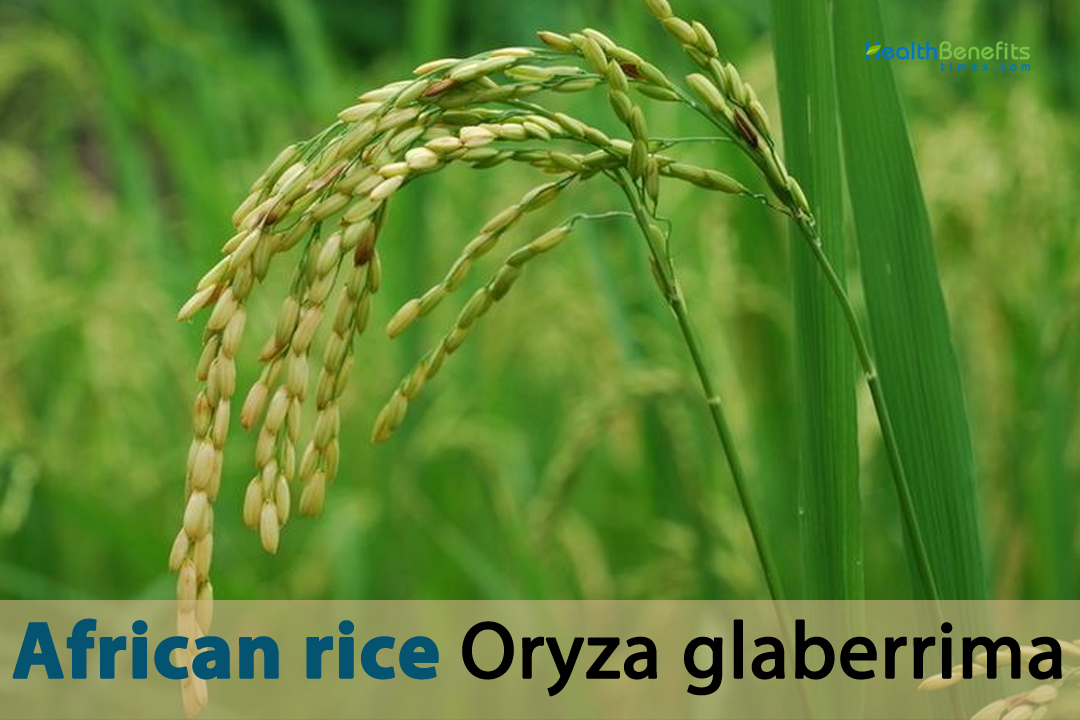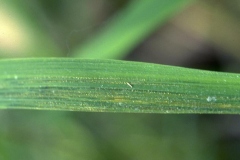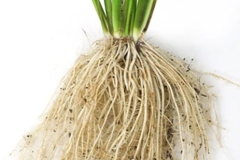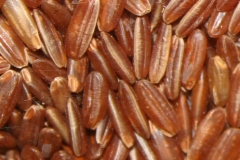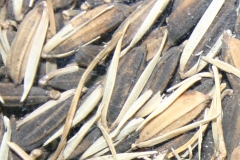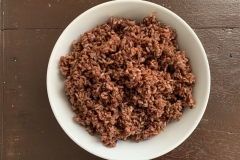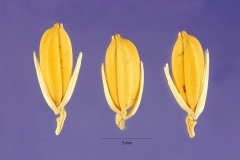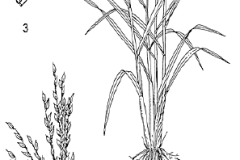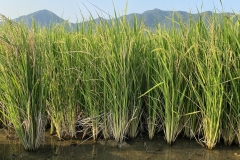| African rice Quick Facts | |
|---|---|
| Name: | African rice |
| Scientific Name: | Oryza glaberrima |
| Origin | West Africa and Western Sudan |
| Colors | White, brown, or even red |
| Shapes | Small, elongated seed enclosed in a protective husk or hull |
| Taste | Somewhat nutty, with a mild, earthy undertone |
| Major nutrients | • Carbohydrates • Protein • Dietary Fiber • B Vitamins • Iron • Magnesium • Phosphorus • Potassium • Zinc • Antioxidants • Phytonutrients |
| Health benefits | Weight Management, Heart Health, Antioxidant Properties, Digestive Health, Immune Support, Bone Health, Anti-Inflammatory Potential, Skin Health, Energy Production |
| Name | African rice |
|---|---|
| Scientific Name | Oryza glaberrima |
| Native | West Africa and Western Sudan including Nigeria, Senegal, Sierra leone, guinea, Liberia, Ghana, Ivory Coast |
| Common Names | African Rice, Water Rice, Moroheiya Rice, Native Rice, Guinea Rice, Tropical Japonica Rice, Bouake Rice, Red Rice, Upland New Rice, Brown Guinea Rice, Lowland Rice, Upland Rice, Swamp Rice, Wild Rice, Bolanse Rice, Madagascar Rice, Nérica Rice, Bouake Rice, Ovambo Rice, Biay Rice, Hill Rice |
| Name in Other Languages | Afrikaans: Afrika-rys Amharic: Tena, Tena rice, Yä’āfirīka wät (የአፍሪካ ወተት), Afrika Ruz (አፍሪካ ሩዝ, አፍሪካ ሩዝ), Y’afriqa rus (የአፍሪቃ ሩዝ) Arabic: Arz ‘Afrīqī (أرز أفريقي), Arz Ifriqi (أرز إفريقي), ‘arz ‘afriqi (أرز أفريقي) Assamese: Aphrikān dhan (আফ্রিকান ধান) Bambara: Faro, Faro rice, Sinankuya Bengali: Aphrikān dhān (আফ্রিকান ধান) Bodo: Aphrikan dhan (आफ्रिकन धान) Bulgarian: Afrikanski oriz (Африкански ориз) Catalan: Arròs africà Chhattisgarhi: Afrikan chawal (आफ्रिकन चावल) Chichewa: Nsima ya Africa Chinese: Fēizhōu dàomǐ (非洲稻米), Guang fu dao, Xīfēi zāipéi dào (西非栽培稻),Fei zhou hong dao(非洲红稻),Fei zhou ye sheng dao (非洲野生稻) Croatian: Afrički riža Czech: Africká rýže, rýže africká Danish: Afrikansk ris Dholuo: Osuji, Osuji rice Dutch: Afrikaanse rijst English: African Rice, African cultivated rice , African red rice, African rice, African upland rice, West African floating rice Filipino: African Bigas Finnish: Afrikkalainen riisi, afrikanriisi French: Riz africain, Riz de Casamance, Riz des Baga, Riz flottant africain, Riz pluvial africain, Vieux riz Fula: Farina, Farina rice Fulah: Maaroori German: Afrikanischer Reis Greek: Afrikanikós rýzi (Αφρικανικός ρύζι) Gujarati: Āphrikan chokho (આફ્રિકન ચોખો) Hausa: Danduwa, Danduwa rice, Taushe, Tuwo masara, Tuwon Shinkafa Hebrew: Orez Afrikai (אורז אפריקאי) Hindi: Afriki chawal (अफ्रीकी चावल) Hungarian: Afrikai rizs Igbo: Oryza africana, Abakiliki rice, Ofada, Ofada rice, Abakaliki Rice Indonesian: Beras Afrika Italian: Riso africano Japanese: Afurika kome (アフリカ米), Afurikaine (アフリカイネ) Kannada: Āphrikān akki (ಆಫ್ರಿಕಾನ್ ಅಕ್ಕಿ) Kashmiri: Afriki chawal (افريقي چاول) Korean: Apeurika ssal (아프리카 쌀) Konkani: Afrikan tandal (आफ्रिकन तांदूळ) Kikongo: Kimpumu, Kimpumu rice Kinyarwanda: Akayove Afurika Luganda: Omuceere ogw’Emizira y’Ebifananyi Maithili: Afrikan chamal (आफ्रिकन चामल) Malay: Beras Afrika Malayalam: Āphrikkan ari (ആഫ്രിക്കൻ അരി) Mandinka: Noko, Noko rice, Nyebbeh Malagasy: Vary Afrikana Manipuri: Aphrikān chābor (আফ্রিকান চাবৰ) Marathi: Āphrikan tānduḷ (आफ्रिकन तांदूळ) Nepali: Aphrikan chamal (अफ्रिकन चामल) Norwegian: Afrikansk ris Odia: Āphrikān chā (ଆଫ୍ରିକାନ ଚା) Oromo: Oromiyaa Rice Persian: Berenj-e Afrikai (برنج آفریقایی) Polish: Ryz afrykanski Portuguese: Arroz africano Punjabi: Afriki chawal (ਅਫ਼ਰੀਕੀ ਚਾਵਲ) Romanian: Orez african Russian: Afrikanskiy ris (Африканский рис) Sanskrit: Afrikan dhan (आफ्रिकन धान) Santali: African bhat (ᱟᱯᱛᱷᱟᱜᱽ ᱠᱟᱯᱛᱷᱟᱜ) Serbian: Africki oriz (Афрички ориз) Sesotho: Likolo tsa Afrika Shona: Chibereko cheAfrica, Tsunga reAfrica Sindhi: Afriki chawal (افريقي چاول) Slovenian: Afriški riž Somali: Bariis Afriiqiyeed, Bariis Afriiq, Afrikanskiiy Ryis, Bariis Afrikaan Spanish: Arroz africano, Arroz de Guinea Swahili: Wali wa Afrika, African rice, Mchele wa Afrika, Mpunga wa Afrika, Mchele wa Kiafrika Swazi: Inyama yomuthi waseNingizimu Afrika Swedish: Afrikanskt ris Tamil: Āppirikka arisi (ஆப்பிரிக்க அரிசி) Telugu: Āphrikān rais (ఆఫ్రికాన్ రైస్) Thai: Khao Afrikka (ข้าวแอฟริกา) Tigrinya: Taǧǧya ‘Afirīqa (ጣጅያ ኣፍሪቃ), African Ruz, Raz Afrika (ራዝ ኣፍሪካ) Tswana: Peraka ya Setšo sa Afrika Turkish: Afrika pirinci Ukrainian: Afrikansʹkyy ris (Африканський рис), Rys afrykansʹkyy (Рис африканський) Urdu: Afriki chawal (افریکی چاول) Vietnamese: Gạo Châu Phi, Lúa châu Phi Wolof: Ceebu jen, Nopp naay, Nopp naa, Noket, Noket rice Xhosa: Ucingo lwemithi yaseAfrika, Umrice we-Afrika Yoruba: Iwe, Iwe rice, Ofada, Ofada rice Zulu: Unhlezi, Unhlezi rice, Inyama yase-Afrika, Ucingo lwemithi yase, Ningizimu Afrika, Isinkwa Sase-Afrika |
| Plant Growth Habit | Very variable, robust, annual grass |
| Growing Climates | Swampy, wet sites, lowland rainforests, swampy areas, upland fields, riverbanks and floodplains, coastal areas, subsistence farming, wetlands, marshes, flooded rice paddies, shallow lakeshores, riparian zones, Estuarine Areas |
| Soil | Grows well in slightly acidic to neutral soils. Soils rich in organic matter are beneficial however, proper drainage is essential to prevent long-term water stagnation |
| Plant Size | 90 to 150 centimetres |
| Root | Fibrous root system |
| Stem | Herbaceous, hollow and non woody stem |
| Bark | Does not have a woody stem with bark like some trees and shrubs |
| Leaf | Typically long, slender, and lance-shaped with entire margins and parallel venation |
| Flowering season | June to September |
| Flower | Spikelet can produce several individual flowers. Each flower consists of a lemma and a palea that are often green or straw-colored |
| Fruit Shape & Size | Small, elongated seed enclosed in a protective husk or hull |
| Fruit Color | Various shades of white, brown, or even red |
| Seed | Small, oval-shaped, and typically flattened on one side. They have a tough outer husk that protects the inner layers of the seed |
| Seed Color | White, brown, red, or even black |
| Flavor/Aroma | Mild to slightly nutty or grassy |
| Taste | Somewhat nutty, with a mild, earthy undertone |
| Propagation | Direct Seeding, Transplanting |
| Lifespan | Within a single year |
| Season | July to October |
| Major Nutrition |
|
| Available Forms |
|
| Health benefits |
|
Plant Description
African rice is an exceptionally variable, robust annual herbaceous plant characterized by erect, sturdy culms that can reach heights of 120 centimeters on average, although some varieties can reach heights of 5 meters. Lowland rainforests, moist sites, estuaries, riparian zones, upland fields, riverbanks, and floodplains, coastal regions, subsistence agriculture, marshes, flooded rice paddies, shallow lakeshores, and riparian zones are all habitats where this plant is observed to thrive. The plant thrives in soils that are neutral to mildly acidic. Although organic matter-rich soils offer certain advantages, they must be adequately drained to prevent prolonged water stagnation. African rice serves as a carbohydrate source, thereby furnishing individuals with energy. Minerals such as magnesium and selenium, as well as proteins and vitamins (especially B vitamins), are also present in it.
West African food security is significantly impacted by African rice, which helps to nourish millions of people in the region. Its ingestion and cultivation are fundamental components of the culinary traditions of numerous West African nations. African rice cultivation encounters various obstacles, including diminished productivity, vulnerability to specific pests and diseases, and competition from Asian rice varieties that produce higher yields. The objective of research and development initiatives is to mitigate these obstacles and improve the rice production in Africa.
Roots
Typically, African rice possesses a fibrous root system, characterized by the formation of an extensive network of thin roots that extend throughout the uppermost stratum of soil. This root system facilitates the plant’s absorption of nutrients and water from the adjacent soil. The roots are tasked with the vital function of absorbing nutrients from the soil, including nitrogen, phosphorus, and potassium. These nutrients are essential for the development and growth of the organism. In addition to facilitating the assimilation of nutrients and water, the roots support the plant by establishing an anchor in the soil. This is particularly critical in areas susceptible to intense precipitation or high winds.
Stem
The stem of African rice is herbaceous, non-woody, and porous. The plant demonstrates an erect or semi-erect growth habit, denoting that its stem extends vertically or at a marginal inclination relative to the ground. This enables the plant to orient its leaves for maximum absorption of sunlight. There are internodes and nodes comprising the stem. Nodes are locations along the stem that serve as attachment points for reproductive structures (panicles), leaves, or branches. The segments of the stem that separate nodes are called internodes.
There are vascular bundles within the stem that comprise xylem and phloem tissues. Phloem transports nutrients, including sugars produced during photosynthesis, from the leaves to other portions of the plant, whereas xylem is responsible for transporting minerals and water from the roots to the rest of the plant. Protecting against water loss, physical injury, and pathogens, the epidermis serves as a barrier against these elements and is the outermost layer of the stem.
Leaves
Typically, the foliage consists of long, slender, lance-shaped leaves. Their straightforward leaf structure comprises a solitary leaf blade that is affixed to the stem via a petiole or leaf stalk. They have an alternate leaf arrangement, which consists of alternating leaf positions along the stem, with one leaf emerging from each node. Plants with parallel venation have veins that extend in a parallel line from the leaf’s base to its apex. Mature leaves frequently exhibit a deeper shade of green compared to their juvenile counterparts. Additionally, environmental factors and nutrient availability can impact leaf hue. The average length of leaves ranges from 20 to 50 centimeters (8 to 20 inches).
Flowers
Rice plants native to Africa generate inflorescences, which are assemblages or clusters of blossoms. These blossoms are referred to as “panicles.” Branching panicles comprise an assortment of diminutive spikelets. Each spikelet is capable of developing multiple blooms. Similar to those of other rice species, the flowers have a straightforward structure. Lemma and palea, two protective bracts that enclose the reproductive organs, comprise each flower. Frequently, the lemma and palea are straw-colored or green in hue. In general, flowers have a straw-colored, yellowish, or mild green hue. Wind is the primary pollinator of flowers. They are insect-pollinable, in contrast to certain other types of flowering vegetation.
Fruits
The rice kernels constitute the fruits. These cereals are harvested for human consumption and constitute the principal agricultural product of the plant. Every granule of rice is an adult seed that has been developed by the reproductive organs of the plant. The development of these seeds occurs within the spikelets of the panicle, the plant’s blossoming structure. A branched structure known as the panicle contains numerous spikelets. Although each spikelet comprises numerous individual flowers, it is generally the case that only a fraction of these flowers progress to complete maturity as rice grains.
Seeds
The African rice plant’s seeds germinate within the panicle’s spikelets, which constitute the blossoming structure of the plant. Although individual flowers may be present in each spikelet, only a subset of them will undergo development into fully mature rice grains. Similar to seeds of other varieties of rice, African rice seeds are small, oval-shaped, and typically one-sidedly flattened. They are protected by a strong outer husk that encases the seed’s inner layers. Diverse varieties of African rice seedlings may exhibit color variation. Possibly black, brown, white, or red, contingent upon the particular variety and environmental circumstances for development. Frequently, the coloring of rice granules affects their flavor and culinary application.
Health benefits of African rice
African rice is a unique and nutritious grain that has been cultivated and consumed in various parts of West Africa for centuries. It offers a range of health benefits, including:
1. Weight Management
The dietary fiber present in African rice contributes to satiety, thereby aiding in weight management by encouraging a sense of satisfaction that discourages overeating.
2. Heart Health
African rice may support cardiovascular health, lower lipid levels, and reduce the risk of cardiovascular disease due to its fiber and phytonutrient content. Additionally, its potassium content may promote healthful blood pressure.
3. Antioxidant Properties
Antioxidants, including phenolic compounds and flavonoids, found in African rice protect cells from oxidative stress and reduce the risk of chronic diseases, such as cardiovascular disease and cancer.
4. Gluten-Free
African rice possesses an inherent absence of gluten, rendering it a wholesome and risk-free option for individuals afflicted with celiac disease or gluten sensitivity.
5. Mineral Content
African rice is an excellent source of calcium, which promotes healthy bones and teeth, and iron, which is crucial for preventing anemia.
6. Digestive Health
African rice contains dietary fiber, which prevents digestive issues and promotes regular bowel movements, thereby contributing to a healthy digestive system.
7. Immune Support
Iron and vitamin B6, among other minerals and vitamins found in African rice, are critical for maintaining a healthy immune system. Sufficient consumption of these nutrients may aid the body’s immune response to pathogens and diseases.
8. Bone Health
Calcium, which is present in African rice, is essential for the maintenance of healthy bones and teeth. Particularly beneficial for those who have restricted availability of dairy products as a calcium source.
9. Anti-Inflammatory Potential
The phytonutrient content of African rice may confer anti-inflammatory properties, according to some studies. This may reduce the likelihood of developing chronic inflammatory conditions.
10. Skin Health
African rice’s antioxidants and minerals can promote skin health through the inhibition of premature aging, stimulation of collagen synthesis, and shielding against ultraviolet damage.
11. Energy Production
African rice is an excellent source of carbohydrates, the primary source of energy for the body. It offers prolonged vitality, rendering it an appropriate selection for individuals who engage in physical activity.
Culinary Uses
- Jollof Rice: Jollof rice is widely recognized and cherished throughout West Africa. African rice is prepared in the presence of a flavorful tomato-based sauce, seasonings, and an assortment of additional ingredients, including meat (chicken, beef, or goat), seafood, or vegetables. Jollof rice is a traditional dietary component of festive events and gatherings.
- Fried Rice: Fried fried rice can also be prepared with African rice. Stir-frying cooked rice with eggs, vegetables, and occasionally meat or seafood. For enhanced flavor, it is seasoned with soy sauce or regional seasonings.
- Plain Steamed Rice: Steamed African rice can be conveniently incorporated into stews, grilled meats, or vegetables, serving as a side dish. Its earthy and nutty flavor enhances an extensive variety of delectable dishes.
- Rice and Stew: Conspicuous accompaniments to African rice consist of substantial and luscious stews, including okra stew, peanut stew (groundnut soup), and tomato-based sauces. The rice assimilates the stew’s flavors, resulting in a gratifying and harmoniously composed repast.
- Jambalaya: Certain West African nations employ African rice in the preparation of a culinary creation akin to jambalaya. Tomatoes, vegetables, and a variety of spices—often chile peppers for a spicy kick—are utilized in its preparation.
- Rice Porridge: Particularly for breakfast, a comforting rice porridge can be prepared with African rice. For a warm and nourishing dish, it is prepared with sugar or sweeteners, cinnamon or nutmeg, and milk or coconut milk.
- Rice Balls: Certain regions employ African rice in the preparation of rice cakes and spheres. Frequent accompaniments to stews and sauces, they are also frequently savored as a side dish.
- Rice Salad: African rice is suitable for use as a foundation in a variety of salads. It is combined with herbs, vegetables, and a vinaigrette to produce a nourishing and revitalizing salad.
- Rice Pudding: Comparable to rice porridge, the sweet and buttery rice pudding can be prepared with African rice. In addition to cinnamon, nutmeg, or vanilla, raisins or other preserved fruits may be incorporated.
- Rice and Beans: African rice and legumes are combined to produce a nourishing and protein-rich dish. Frequently, this mixture is prepared using a tomato-based sauce and seasoned with various seasonings.
- Rice Pancakes: Certain West African cuisines employ powdered African rice in the preparation of fritters or rice pancakes. These are served as an appetizer or refreshment after being fried until crisp.
- Rice Fufu: Certain cultural traditions involve the shaping and pounding of African rice into a glutinous side dish called “rice fufu.” It is frequently accompanied by sauces and soups.
Different Uses
- Cultural and Traditional Rituals: Cultural festivals, traditional ceremonies, and rituals frequently incorporate African rice. It possesses substantial cultural significance and is occasionally employed in religious observances as an offering to deities or ancestors.
- Ornamental and Decorative: African rice stalks and kernels have been incorporated into traditional crafts, including the creation of ornaments, jewelry, and woven baskets. Due to their distinctive appearance, African rice grains are highly sought after in artistic endeavors.
- Soil Improvement: It has been acknowledged that African rice has the capacity to increase soil fertility. Due to its nitrogen-fixing characteristics, when cultivated in rotation with other crops, it can assist in increasing soil nitrogen levels and enhancing soil health.
- Erosion Control: To mitigate soil erosion, African rice has been cultivated in vulnerable areas and along riverbanks in certain regions. Its root system can reduce the risk of soil erosion brought on by intense precipitation or flooding by stabilizing the soil.
- Biodiversity Conservation: Constraints have been established to safeguard and preserve indigenous African rice varieties in conjunction with more extensive initiatives to conserve biodiversity. The conservation of these indigenous varieties contributes to the sustenance of genetic diversity and the capacity to adapt to shifting environmental conditions.
- Genetic Resource for Breeding: The genetic diversity of African rice is crucial for rice breeding initiatives. It possesses advantageous characteristics, including drought tolerance, resistance to particular pests and diseases, and adaptability to local conditions. By incorporating these characteristics into contemporary rice varieties, one can increase crop yields and resilience.
- Traditional Craft Making: African rice straw is utilized in certain communities to weave receptacles, hats, and mats. Straw is cured, dyed, and subsequently woven into a variety of ceremonial and everyday objects.
- Animal Feed: Occasionally, African rice straw and husks are utilized as animal fodder, especially in resource-constrained rural regions. It supplies animals with both nutrition and roughage.
- Research and Conservation: Preserving the genetic diversity and cultural significance of African rice is the focus of ongoing research and conservation initiatives. This entails the documentation of traditional knowledge pertaining to the cultivation and utilization of African rice.
Side effects
- Allergies: Certain people might develop sensitivities or allergies to particular grains, such as rice. You should abstain from African rice and all other varieties of rice if you have an allergy to rice or develop symptoms such as pruritus, inflammation, edema, or respiratory distress subsequent to doing so.
- Contaminants: Similar to other agricultural commodities, African rice has the potential to come into contact with impurities including heavy metals, pesticides, and mycotoxins. To prevent contamination, it is critical that African rice be cultivated, processed, and stored in accordance with quality and safety standards.
- Weight Gain: Although African rice does not directly induce weight gain, its overconsumption or incorporation into high-calorie concoctions (e.g., fried rice with copious amounts of oil) may gradually contribute to weight gain. When producing rice-based dishes, it is critical to avoid overeating and instead opt for nutritious cooking techniques.
- Digestive Sensitivity: Certain people who have digestive sensitivities or conditions such as irritable bowel syndrome (IBS) may encounter abdominal pain or congestion following the consumption of rice, including African rice. Optimizing whole-grain African rice varieties and modifying portion sizes may potentially mitigate the aforementioned symptoms.
- Nutrient Absorption: Similar to other cereals, African rice is composed of phytates, which are compounds that impede the absorption of specific minerals, including zinc and iron. Nevertheless, this is typically not a substantial issue when incorporated into a varied dietary regimen. Incorporating African rice with vitamin C-rich foods has the potential to augment iron assimilation.
References:
https://www.cabidigitallibrary.org/doi/10.1079/cabicompendium.37961
https://gd.eppo.int/taxon/ORYGL
https://en.hortipedia.com/Oryza_glaberrima
https://tropical.theferns.info/viewtropical.php?id=Oryza+glaberrima
http://ngp.parc.gov.pk/gringlobal/taxon/taxonomydetail?id=26062
https://plants.usda.gov/home/plantProfile?symbol=ORGL2
https://www.wikidata.org/wiki/Q2670252
https://en.wikipedia.org/wiki/Oryza_glaberrima


